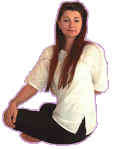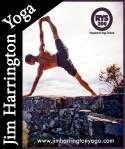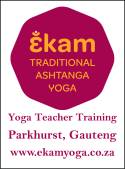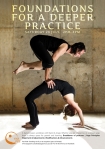Salute to the Moon
Sanskrit Name – Chandranamaskar
In yoga this elegant flow of seven repeated postures linked by breath and movement is in honour of the moon.





 6 Exhale and place your hands on either side of your left foot. Change feet by jumping the right foot forwards between the hands and take the left foot back. Drop the left knee to the floor.
6 Exhale and place your hands on either side of your left foot. Change feet by jumping the right foot forwards between the hands and take the left foot back. Drop the left knee to the floor.
 7 Inhale and stretch your arms up above your head as you lean backwards into the Crescent Moon again.
7 Inhale and stretch your arms up above your head as you lean backwards into the Crescent Moon again.
 8 As you breathe out lower your arms and step your right foot back, lowering your buttocks to your heels. Place your forehead on the floor. This is called the Puppy Stretch.
8 As you breathe out lower your arms and step your right foot back, lowering your buttocks to your heels. Place your forehead on the floor. This is called the Puppy Stretch.
 9 Inhale, raising your hands, arms, head and chest, lifting yourself into an upright kneeling position, with your buttocks off your heels. This posture is called the Rabbit.
9 Inhale, raising your hands, arms, head and chest, lifting yourself into an upright kneeling position, with your buttocks off your heels. This posture is called the Rabbit.
 10 Exhale back into the Puppy Stretch.
10 Exhale back into the Puppy Stretch.
 11 When you breathe in raise your arms, head and chest and come back into the Rabbit. Curl your toes under.
11 When you breathe in raise your arms, head and chest and come back into the Rabbit. Curl your toes under.
 12 Breathe out and lower your arms, coming into a full squat.
12 Breathe out and lower your arms, coming into a full squat.
 13 Inhale and straighten up into a standing posture as you raise your arms forward and above your head and lean backwards.
13 Inhale and straighten up into a standing posture as you raise your arms forward and above your head and lean backwards.
 14 Exhale into the Mountain Posture. Step to the front of your mat. Repeat the sequence taking the left foot back in step 4 and forwards in step 6. This comprises one round of Salute to the Moon.
14 Exhale into the Mountain Posture. Step to the front of your mat. Repeat the sequence taking the left foot back in step 4 and forwards in step 6. This comprises one round of Salute to the Moon.
Try to do five complete rounds of Salute to the Moon. The elegance and comfort of this sequence is closely related to breath control. It is essential to do long, slow yoga (ujjayi) breathing or else you will become breathless and tired and the exercise will not be an enjoyable experience.
Until recently I always wondered why step nine was called the Rabbit. If you look carefully at the full moon on a clear night you can sometimes see an image that looks like a man holding his arms above his head. We call this the ‘man in the moon’. In India the image is known as the rabbit – instead of arms above his head – those appendages are the long ears of the rabbit.
________________________________
 Amber Land completed her yoga teacher’s training at Ananda Kutir Yoga Centre in Cape Town in 1992 and has been teaching yoga ever since. She is trained and teaches in the Sivananda Integral Yoga Style, incorporating what she considers the best aspects of other schools into her teaching. amberland@vodamail.co.za | www.hathayoga.co.za
Amber Land completed her yoga teacher’s training at Ananda Kutir Yoga Centre in Cape Town in 1992 and has been teaching yoga ever since. She is trained and teaches in the Sivananda Integral Yoga Style, incorporating what she considers the best aspects of other schools into her teaching. amberland@vodamail.co.za | www.hathayoga.co.za





























